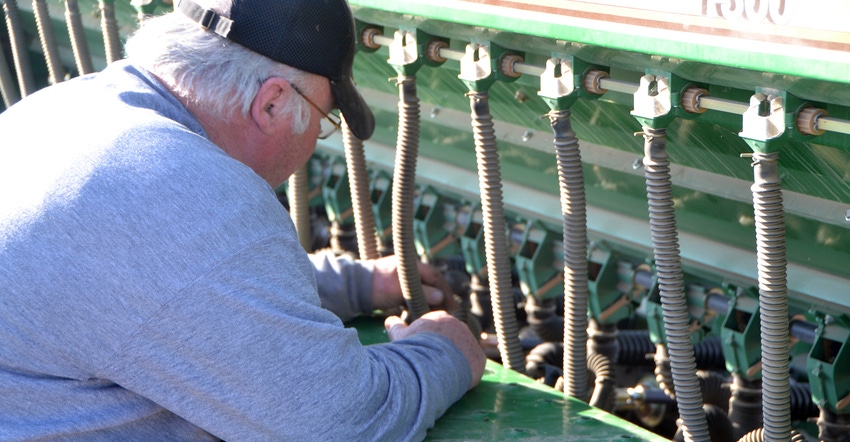February 15, 2017

With corn planters, uniformity in depth and spacing, both within and between rows, is a precise science. With small grains, at least in Iowa, equipment with that precision isn’t available or affordable (excluding singulation in oats). Most Iowa farmers are either using conventional or no-till drills, or broadcasting seed and then incorporating it.
“We have to make sure we have good soil-to-seed contact,” says Aaron Heley Lehman, who farms near Polk City, growing corn, soybeans, oats and hay. “And that really hasn’t been an issue with our corn and soybeans for quite a while, because our planters have been adapted to that,” he says. “Our seeders for small grains have not.” Because the technology isn’t able to place seed as precisely as with corn or soybeans, “we need to make sure that all the things we can control are ideal.”
For spring-planted small grains, especially oats, some of these factors are planting date, planting depth and seedbed condition. Ideal planting conditions are early in the season, a firm seedbed and uniform depth.
The earlier the better
Depending on soil moisture conditions, early could mean anywhere from early to mid-March in southern Iowa, to late March and early April in the northern half of the state.
“If frost is out of the ground and topsoil is dry, it’s time to plant,” says Dan Wilson of Paullina. “We have put in oats when the snowbanks were still in the road ditches. If the soil conditions are right to plant, we’ll put them in. We think the earlier the better.”
For Wilson, who farms in far-northern Iowa, those conditions usually occur in early April, but sometimes it’s March. “I’ve been planting oats for about 40 years, and we’ve only planted in March maybe three or four years,” he says, “but I’m not averse to putting them in in March, if conditions are right.”
For Vic Madsen, who farms farther south, near Audubon, planting in mid- to late March is optimal. He used to be a little worried about planting so early, but after seeing differences in yield, he’s convinced. “In the past, we always waited until mid-April,” he says. But last year, he planted some oats in March and some in April. “The early-planted oats yielded significantly better,” he says.
Oats and other small grains are, after all, cool-season crops. They develop and grow much more efficiently under cool conditions. “Oats will germinate when it’s cold,” Madsen says. “Then they’ll fill when it’s not so beastly hot, because they don’t like to fill with 85 degree F temperatures like you get in late June.
“It seems in late March, there’s a day or two when it’s dry,” he says, and that’s the day to plant. In 2016, that day was March 10. That’s one of the reasons Madsen likes planting into bean stubble. If you get that dry day in March, you can just go plant, and don’t have to worry about multiple tillage passes to get the seedbed ready to go.
Seed-to-soil contact
The seedbed is important for a number of reasons. One is to ensure good seed-to-soil contact, enabling the seed to quickly imbibe water and germinate. If it gets out of the ground faster, it has more time to grow in the early, cool weather. The other reason a firm, uniform seedbed is important is uniform depth. An uneven seedbed makes it tricky to get consistent down-pressure and consistent seed placement.
A no-till drill is one good tool that can allow farmers to accomplish those goals without disturbing the soil. Ron Rosmann, a southwest Iowa farmer, bought a Great Plains no-till drill a few years ago, and it does a great job. “It's a very versatile machine. It decreases the tillage and ensures you have the seed planted where it needs to be, at proper depth.” Depth control is a result of a number of different adjustments you can make to fine-tune the drill.
No-till drills can be pricey, and a conventional drill can work for small grains as well, he says, and that could be a good option for someone just getting started with small grains. “There's nothing wrong with buying a different drill that isn't no-till,” he says. “You have to have a decent seedbed if you're going to get small grains out of the ground though,” Rosmann says, so that might mean some disking, especially following corn. “It's a lot better to follow soybeans than it is for corn. It’s a lot harder to break down the cornstalks to get a good enough seedbed that you're going to have a nice even stand of small grains in, unless you do more tillage,” he says.
Regardless of the drill, making sure you’re planting where you want is crucial. “When you’re planting any crop, you have to get off the tractor and see where the seed is,” Rosmann says. “And with small grains like oats and barley, you need to be in the ground about 1 to 2 inches; that would probably be ideal.”
As with corn and soybeans, the depth itself is important. Too shallow and there won’t be enough moisture; too deep and the seed will use up too many resources getting to the surface. But uniformity is another factor. When seeds are in the soil at about the same depth, they’ll be more likely to emerge at the same time and maintain uniformity throughout the year.
You can find videos about Iowa small-grain production in PFI’s new video series, Rotationally Raised, at youtube.com/pfivideos. Episode No. 5, Planting II – Seed to Soil, focuses on planting date, planting depth and seedbed preparation. To learn more about small-grain production in Iowa, check out Practical Farmers of Iowa’s web page, practicalfarmers.org/small-grains. There, you can find research reports, production manuals, articles, blogs, conference presentations and more.
Ohde writes for PFI in Ames.
About the Author(s)
You May Also Like






